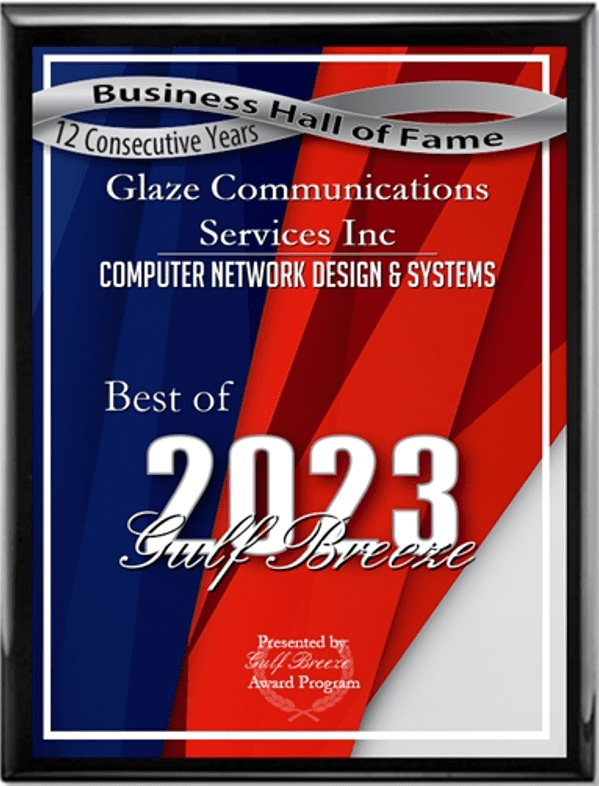Structured Cabling Services in Florida
Depend on Glaze Communications. Glaze Communications is Northwest Florida’s trusted source for structured cabling. Our services provide exceptional, quality designed installations to be manageable, reliable, and scalable. Depend on Glaze Communications to ensure your network is optimized for the hardware, transactions, and service offering unique to your enterprise.

An IT Network is the lifeline of any business, and when it comes to installing network cabling and data wiring, demand only the most trusted hands. With over 20 years of experience in the network cabling business, our expertise is second to none. Whether you’re needing new server installations or updates and network modifications, our technicians will set up the most reliable and effective server system for your company’s needs. From a single server installation to a large-scale data center, Glaze will meet your structured cabling needs with the highest professional standards of design and installation.
The Cabling Installations We Offer
Structured Network Cabling
Organizations today depend on IT networks to not only run their business but transact business with vendors, contractors and customers. A structured cabling network is a complete system of cabling and associated hardware, which provides a comprehensive telecommunications infrastructure for telephone service or data transmission through a computer network. Cabling can refer to copper or fiber optic cables and may include wireless access points. The quality of the installation, wiring standards and products used will determine the reliability of any network.
Glaze Communications follows TIA/EIA Structured Cabling Standards in every installation to ensure consistency, conformance to physical & transmission line requirements and to accommodate for potential future expansion. GCS pulls from 19 years of cabling experience when consulting, designing and providing structured network cabling solutions.
Fiber Optic CablingThe demand for almost instant results is becoming the norm, especially when an organization wants to make business decisions. Implementing a fiber optic network is one way to increase the data access/delivery speed. Telecommunications companies, internet service providers and cable television distribution companies understand the advantages of fiber optics, especially over long distances. Optical fiber cable has a much higher capacity, bandwidth and speed (100 Gbps or greater) without losing strength or being interfered with. Large businesses, hospitals, airports, DoD installations and banking systems are the types of organizations utilizing optical technology. However, small businesses are also starting to see the benefits and incorporating fiber optics in their network design.
Glaze Communications is specialized in single and multi-mode fiber optic cabling systems. Experienced, qualified technicians cable sensitive, multi-building, multi-floor environments ensuring fiber optic advantages are fully leveraged. Beyond the cabling tasks, GCS also splices, terminates and tests all types of fiber optic cable.
Electronic Private Automatic Branch Exchange (EPABX)A private branch exchange (PBX) is a telephone exchange serving a business or office, as opposed to one common carrier or telephone company operating for many businesses or the general public.
One main advantage of an EPABX is the ability to use two or more telephone lines among eight or more users. More sophisticated EPABX machines are capable of handling 12 lines and distributing them to even 100 or more users. These systems are scalable as your business grows starting with two lines and add on more lines needed. Other features often include hold-music, find me/follow me, mobile integration and call recording.
The PBX is owned and operated by the enterprise rather than the telephone company (which may be a supplier or service provider, however). Private branch exchanges used analog technology originally. Today, PBXs use digital technology (digital signals are converted to analog for outside calls on the local loop using plain old telephone service (POTS ).
A PBX includes,
- Telephone trunk (multiple phone) lines that terminate at the PBX
- A computer with memory that manages the switching of the calls within the PBX and in and out of it
- The network of lines within the PBX
- A console or switchboard for a human operator (optional)
In some situations, alternatives to a PBX include centrex service (in which a pool of lines are rented at the phone company’s central office), key telephone systems, and, for very small enterprises, primary rate Integrated Services Digital Network (ISDN).
Key / VoIP Telephone SystemsKey Phone systems are traditionally used by companies with 50 employees or less and require fewer features. Key systems typically have one unit – an attendant phone or separate box—that acts as a controller for a limited number of lines for a limited number of extensions. They offer convenient elements such as hold buttons, lights, intercoms, paging, speakerphones, privacy, music-on-hold, long-distance restriction, timers, and memory dialing.
Voice over Internet Protocol is a category of hardware and software enabling the Internet to be used as the transmission medium for telephone calls by sending voice data in packets using IP rather than by traditional circuit transmissions of the PSTN. One advantage of VoIP is the telephone calls over the Internet do not incur a surcharge beyond what the user is paying for Internet access. In addition, they are easy to install, portable and include features such as clear HD conversations, caller ID, call blocking and even encrypted communications.
Glaze Communications offers telephone system installations and configurations for all business sizes. Understanding your business and the frequency or volume of phone calls helps determine the type of system recommended to satisfy those needs.
The Systems and Services We Provide
- Structured Cabling Systems
- Sound/Paging/Audio/Video Systems
- Telephone and Voice Mail Systems
- Sound Masking Systems
- Design Build Services
- Interior Cable Placement
- Outside Plant Construction
- Telecommunications Closet Design
- Competitive pricing and bidding
- Affordable, on-time installations
- We own all the tools required to test, troubleshoot, and certify fiber optic and copper cabling systems
